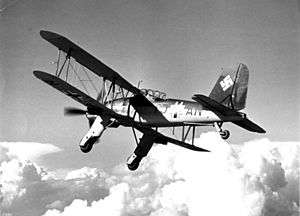Fieseler Fi 167
| Fi 167 | |
|---|---|
 | |
| Fi 167 A-05 | |
| Role | Torpedo bomber |
| National origin | Nazi Germany |
| Manufacturer | Fieseler |
| First flight | 1938 |
| Primary users | Luftwaffe Air Force of the Independent State of Croatia |
| Produced | 1938-1940 |
| Number built | 14 |
|
| |
The Fieseler Fi 167 was a 1930s German biplane torpedo and reconnaissance bomber designed for use from the Graf Zeppelin class aircraft carriers under construction from 1936 to 1942.
Development
In early 1937, the Reichsluftfahrtministerium (German Ministry of Aviation) issued a specification for a carrier-based torpedo bomber to operate from Germany's first aircraft carrier, the Graf Zeppelin construction of which had started at the end of 1936. The specification was issued to two aircraft producers, Fieseler and Arado, and demanded an all-metal biplane with a maximum speed of at least 300 km/h (186 mph), a range of at least 1,000 km and capable both of torpedo and dive-bombing.[1] By the summer of 1938 the Fiesler design proved to be superior to the Arado design, the Ar 195.
The aircraft exceeded by far all requirements, had excellent handling capabilities and could carry about twice the required weapons payload. Like the company's better known Fieseler Fi 156 Storch, the Fi 167 had surprising slow-speed capabilities; under the right conditions, the plane would be able to land almost vertically on a moving aircraft carrier.
For emergency landings at sea the Fi 167 could jettison its landing gear, and airtight compartments in the lower wing would help the aircraft stay afloat at least long enough for the two-man crew to evacuate.
Two prototypes (Fi 167 V1 and V2) were built, followed by twelve pre-production models (Fi 167 A-0) which had only slight modifications from the prototypes.
Operations
Germany
Since the Graf Zeppelin was not expected to be completed before the end of 1940, construction of the Fi 167 had a low priority. When construction of the Graf Zeppelin was stopped in 1940, the completion of further aircraft was stopped and the completed examples were taken into Luftwaffe service in the Erprobungsgruppe 167 evaluation/test unit.
When construction of the Graf Zeppelin was resumed in 1942 the Ju 87C took over the role as a reconnaissance bomber, and torpedo bombers were no longer seen to be needed. Nine of the existing Fi 167 were sent to a coastal naval squadron in the Netherlands and then returned to Germany in the summer of 1943. After that they were sold to Croatia,[2]
The remaining planes were used in the Deutsche Versuchsanstalt für Luftfahrt (German Aircraft Experimental Institute) in Budweis, Czechoslovakia, for testing different landing gear configurations. The large wing area and low landing speeds made it difficult for the Fi 167 to properly carry out the tests so the two test aircraft had their lower wings removed just outboard of the landing gear.
Croatia
The Fi 167's short-field landing and load-carrying abilities made it ideal for transporting ammunition and other supplies to besieged Croatian Army garrisons, between their arrival in September 1944 and the end of the War.
During one such mission, near Sisak on 10 October 1944, an Fi 167 of the Air Force of the Independent State of Croatia was attacked by five North American Mustang Mk IIIs of No. 213 Squadron RAF. The crew of the Fieseler had the distinction of shooting down one of the Mustangs before itself being shot down—possibly one of the last biplane "kills" of the war.[3]
To date, no examples of this aircraft are known to have survived.
Operators
- Zrakoplovstvo Nezavisne Države Hrvatske received between 8 and 12 aircraft in September 1944
Specifications (Fi 167)
Data from Warplanes of the Third Reich.[4]
General characteristics
- Crew: 2 (pilot and gunner)
- Length: 11.40 m (37 ft 4¾ in)
- Wingspan: 13.50 m (44 ft 3½ in)
- Height: 4.80 m (15 ft 9 in)
- Wing area: 45.52 m² (489.8 ft²)
- Empty weight: 2,806 kg (6,173 lb)
- Loaded weight: 4,509 kg (9,920 lb)
- Max. takeoff weight: 4,859 kg (10,690 lb)
- Powerplant: 1 × Daimler-Benz DB 601B liquid cooled inverted V12, 809 kW (1,100 PS)
Performance
- Maximum speed: 325 km/h (176 knots, 202 mph)
- Cruise speed: 250 km/h (135 knots, 155 mph)
- Range: 1,300 km (703 nmi, 808 mi)
- Service ceiling: 8,200 m (26,900 ft)
Armament
- Guns: 1 × 7.92 mm MG 17 machine guns, 1 ×MG-15 machine gun in rear cabin.
- Bombs:
- 1 × 1000 kg (2,200 lb) bomb or
- 1 × 765 kg (1,685 lb) torpedo or
- 1 × 500 kg (1,100 lb) bomb plus 4 × 50 kg (110 lb) bombs
See also
- Related development
- Aircraft of comparable role, configuration and era
- Related lists
- List of World War II military aircraft of Germany
- List of military aircraft of Germany
- List of RLM aircraft designations
Notes
References
- Green, William. Warplanes of the Third Reich. New York: Doubleday, 1972. ISBN 0-385-05782-2.
- Lisko, T. and Canak, D., Hrvatsko Ratno Zrakoplovstvo u Drugome Svejetskom Ratu (The Croatian Airforce in the Second World War) Zagreb, 1998. ISBN 953-97698-0-9
- Savic, D. and Ciglic, B. Croatian Aces of World War II Osprey Aircraft of the Aces - 49, Oxford, 2002 ISBN 1-84176-435-3.
External links
| Wikimedia Commons has media related to Fieseler Fi 167. |